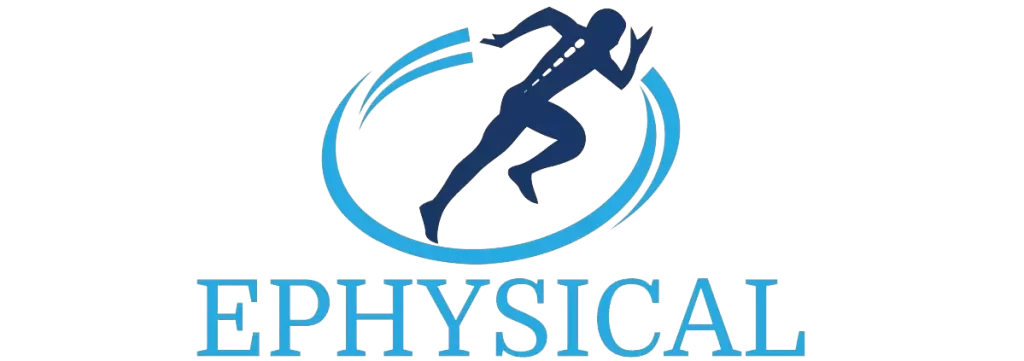Quadratus Lumborum Stretch: 10 Best QL Stretches and Muscle Release Technique
This article will show you different exercises and techniques to achieve quadratus lumborum stretch most effectively and safely.
Let me explain the function and importance of QL quickly, so I will move on to the best QL stretch exercises and release techniques.
What is Quadratus Lumborum (QL)?
The quadratus lumborum is a deep muscle in the back located on both sides of the back. It is quadrangular in shape and connects the iliac bone, transverse process of the five lumbar vertebrae and the lower part of the twelfth rib.
With bilaterally QL activation, your lumbar spine extends or stabilizes.
With unilateral QL activation, lateral torso flexion occurs.
This muscle also affects breathing and acts as an auxiliary muscle when inhaling. (supporting role)
Tight QL on one side leads to lateral pelvic tilt posture.
Quadratus Lumborum Tightness Test
Let me show you a few tests that indicate tightness in the quadratus lumborum.
The first way is to ask someone to palpate your QL muscle. (preferably physical therapist).
The best way to do so is to:
Lie on your side and bend your legs at the hip so that your pelvis rotates backward into posterior pelvic tilt.
Since QL muscle finds below erector spinae muscle, a person should palpate beneath erector spinae muscles to reach QL.
Pain and tension on palpation of the QL indicate QL tightness.
Another way to test tightness in QL is to bring the body into position when the QL muscle stretches.
Here is how you can test quadratus lumborum tightness by yourself:
Perform lateral flexion in your torso while seating. That means you should flex your torso to one side.
You’re stretching the left QL muscle when you bend your body to the right.
Here is how you can test QL tightness with help from a friend:
1. Lie on your stomach
2. Put a pillow under your hips (SIAS height)
3. Let your friend move your both legs to one side
4. Pain or discomfort in QL muscle area while sitting indicates QL muscle tightness.
Don’t forget to test both sides because the QL muscle is very often problematic only on one side.
Why is Quadratus Lumborum Important for Your Body?
The quadratus lumborum muscle is significant for:
- Hip stabilization when standing
- Walking
- Lower back health
- Breathing (inhale)
The QL muscle is one of the most common causes of lower back pain.
Considering that it attaches to all five lumbar vertebrae, its influence is significant on the health of this part of the spine.
It also participates as an auxiliary muscle in inhalation because it attaches to the twelfth rib. People with QL muscle pain often experience back pain when sneezing.
The QL muscle is part of the core muscle group, which increases its influence even more during walking or sports activities.
This muscle is significant for walking.
When you swing your right leg, the left quadratus lumborum keeps your pelvis in the air and allows you to walk without hindrance.
A weak QL causes one side of the pelvis to drop when walking.
While, on the other hand, tight quadratus lumborum contributes to the emergence of lateral pelvic tilt posture.
Quadratus Lumborum Stretch with 10 Effective Exercises
Standing QL Stretch
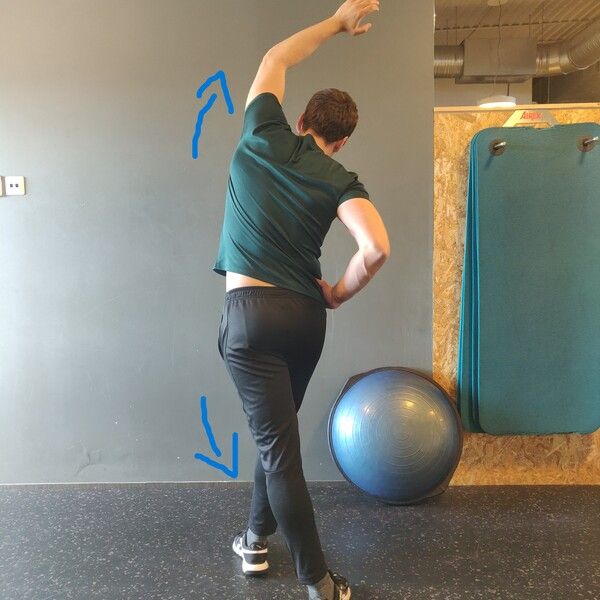
Here is how you perform standing ql stretch.
From a standing position, cross your legs so that your left leg comes behind your right leg.
Then, raise your left hand and bend your body to the right side. Bend your body slightly forward. Hold for 30s.
This exercise is for stretching the left QL and is one of the basic stretching exercises for tight QL muscle
Standing QL stretch with Bar Ladder
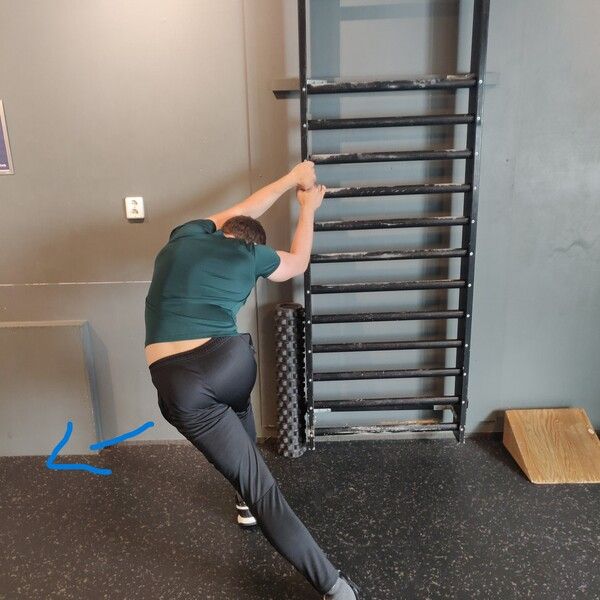
Stand opposite the bar ladder and grab the bar ladder with both hands.
Then, cross your legs so that your left leg comes behind the right. Holding the bar ladder with your hands all the time, slowly slide with your left leg even more and bend your torso to side.
Hold for 30s.
To increase stretching intensity on the left QL, just push with your hip to your left.
This variation is one of the most popular quadratus lumborum stretch people perform nowadays.
QL Wall Stretch Side Standing
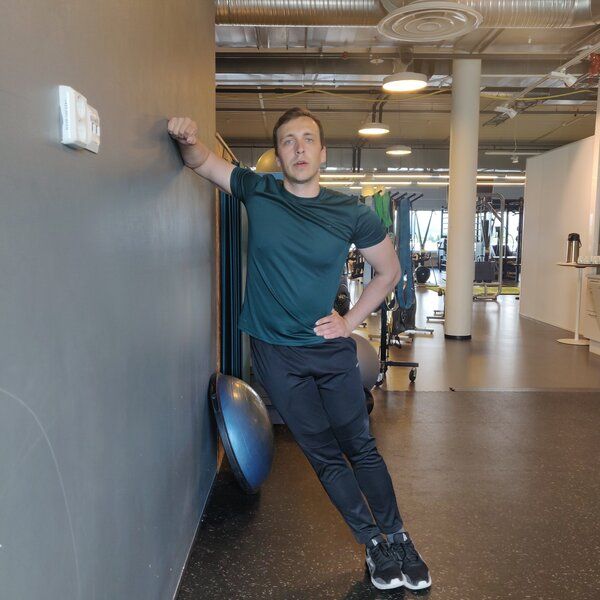
Stand next to a wall and place your forearm on the wall.
Now, relax your upper body and push your hips toward the wall with your other arm. Hold for 30s.
QL Wall Front Stretch
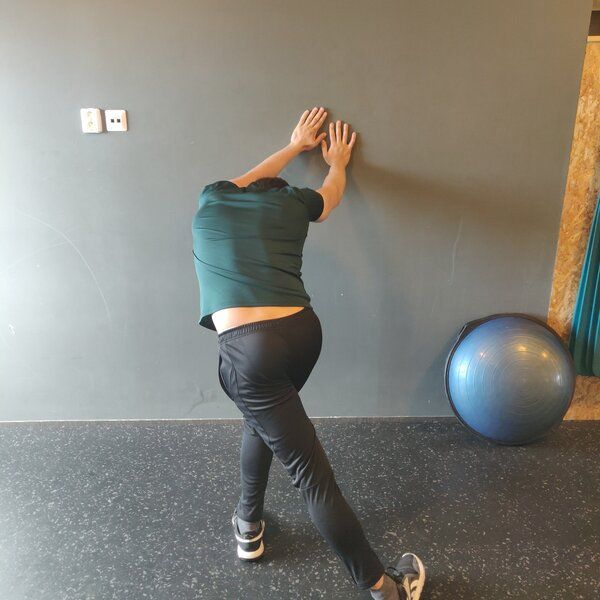
This exercise is similar to first two stretches above, but here is a catch.
When you’re holding your hands on the wall, you can achieve more flexion in your torso.
That means you will target QL both with increased flexion and rotation to the opposite side.
Start with bending your body forward and placing your hands on the wall. Then, cross your legs and let your hips slide slowly in the opposite direction than your leg/hands on the wall.
Seated QL Stretch
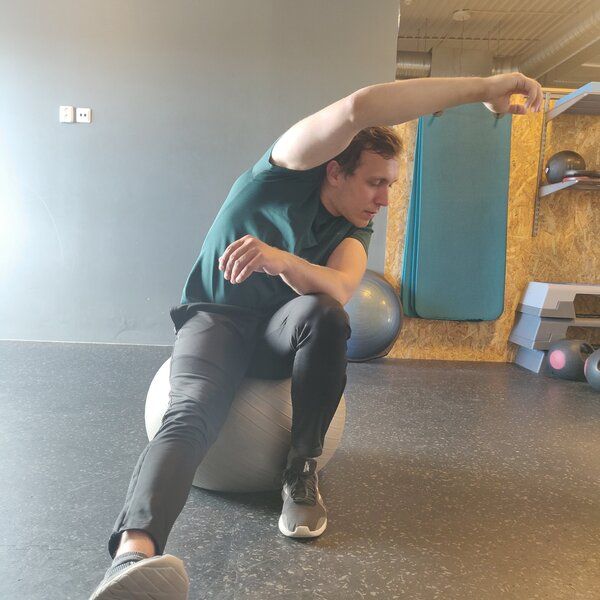
Sit on the ball or chair. Extend one leg and rotate your leg internally. (see picture above). Then raise your arm above your head and side bend your body towards the non-extended leg. Hold for 30s.
Side Lying QL Stretch
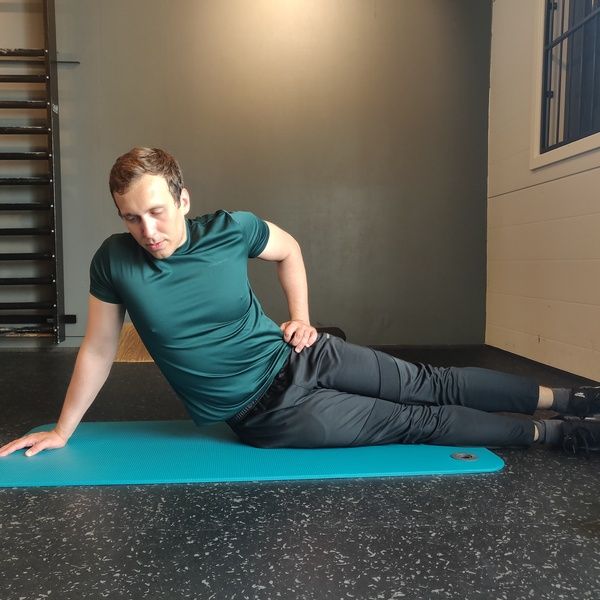
Lay down on your side. Place your hand on the ground and push your body against the floor. Hold for 30.
Make sure you relax your ab muscles during this exercise.
Side Lying QL Stretch with Yoga Ball
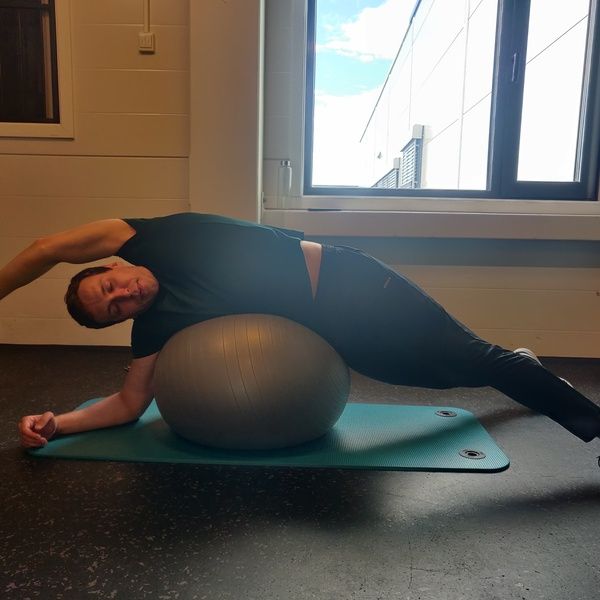
Place your body in side lying position on Yoga ball.
Keep good distance between your feet to achieve better stability.
Raise your arm above your head while pushing down your pelvic. (opposite from lateral pelvic tilt). Hold for 30s.
Side Lying QL Stretch with Rotation
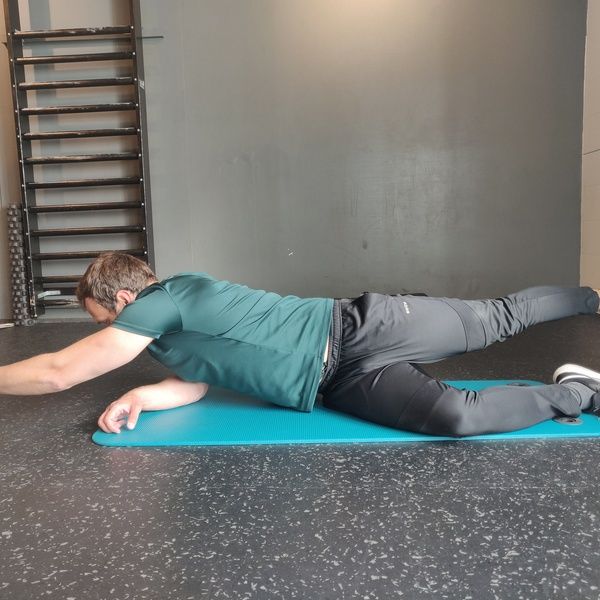
From lying on your right side, raise your left arm above head and rotate your upper body toward right side.
Simultaneously extend your upper leg while rotating your hip internally.
Perform this exercise with 10s hold or repeat the movement ten times.
I would say this variation is advanced quadratus lumborum stretch because it include both upper and lower body movement.
QL Stretch Sitting on Heels
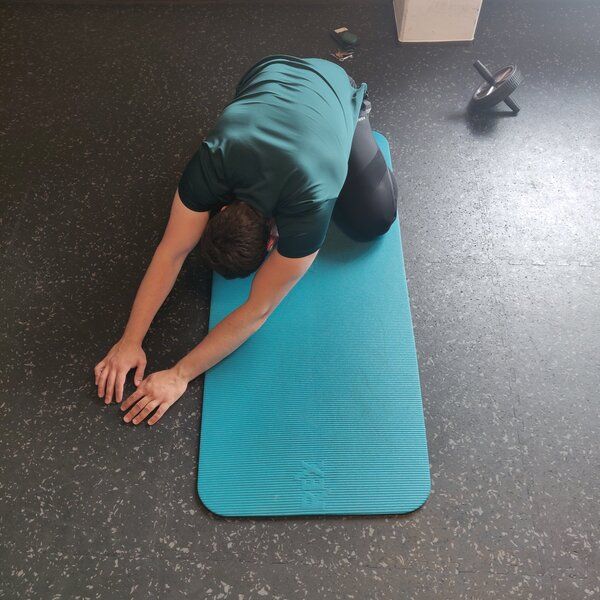
Sit on your heels and place your hands in front of your body as much as you can.
Then move your hands to one side. Hold for 30.
QL Stretch Sitting on Heels with Yoga Ball
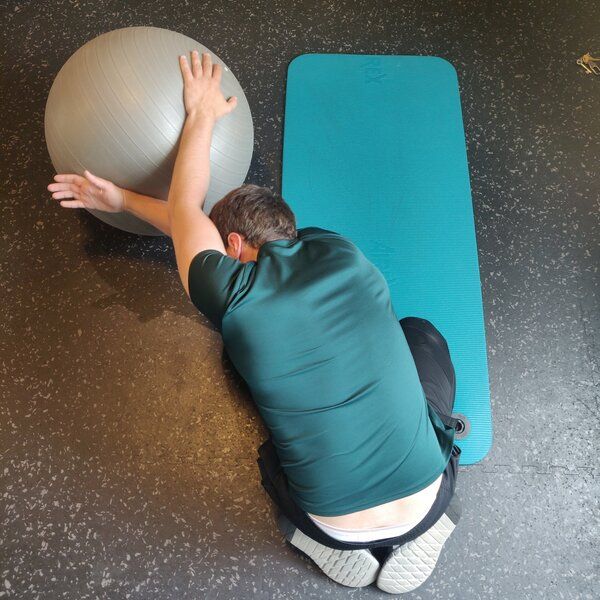
Start from sitting on your heels stance.
Place your hands on the yoga ball. Now slide with upper part of your forearm to one side.
Sliding to your left will stretch the right QL muscle. Hold for 30s.
How to Release Your QL muscles
Using a small ball is the most effective way to release your QL muscle.
Make sure you don’t use a foam roller because you can easily cause more harm than good to your back.
Now I will show you the best way to release your QL muscle.
Lie on your back and lift one side of your back up to place the ball right on the QL muscle.
Avoid placing the ball on your ribs, the lumbar vertebrae and the pelvis.
After placing the ball on the QL, you can release the QL muscle by doing the following:
- Posterior pelvic tilt
- You rotate your leg to the side (hip abduction)
- Rotate your body to opposite side (rotate to the left if you are releasing side ql muscle
- Hold in that position for 10 seconds
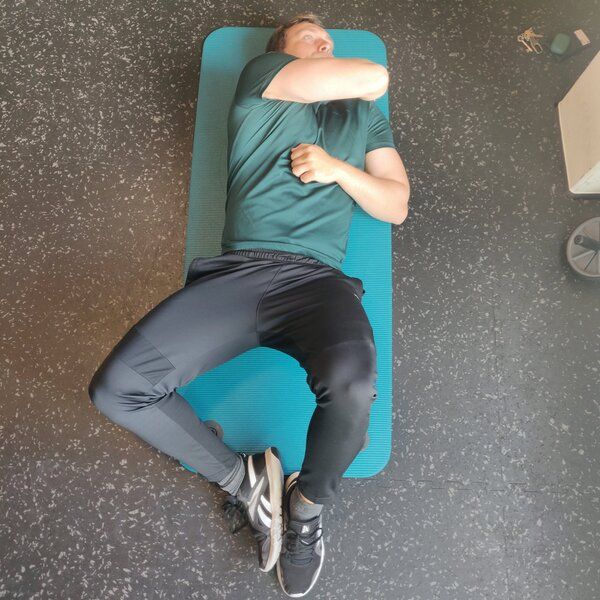
Then, move the ball a little above or below and repeat the same.
From personal experience, I think that 3-4 points are enough to cover the QL muscle with this simple and effective release technique.
Why is My QL Muscle Tight
Tightness in QL muscle occurs mostly because of poor body posture or repetitive lifting weights from the ground and twisting of the upper body.
Having a proper sleeping or sitting position is significant for keeping your QL muscles healthy.
Sleeping on one side can, over time, mess up one of your QL muscles. Constant one-sided overstretching of your ql muscle will make your ql muscle prone to tightness.
If you always sleep on your left side, you can experience tightness in your right QL muscle.
On the other hand, having a proper sitting position all the time is extremely difficult. After sitting for one hour or more, it is easy to rotate your body more to one side without even noticing that.
This body position will stretch one QL and make your back muscle prone to tightness as well.
Improve your flexibility with home stretching equipment, and improve your knowledge about stretching by reading the best books about stretching or my unique stretching book that I highly recommend for beginners.
